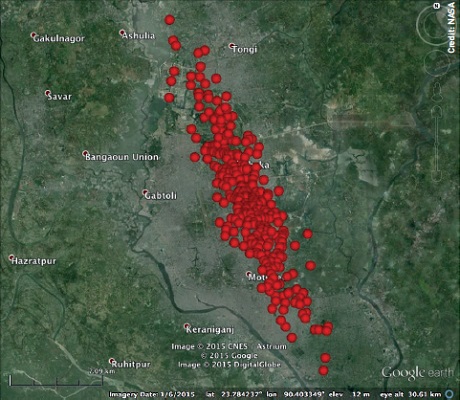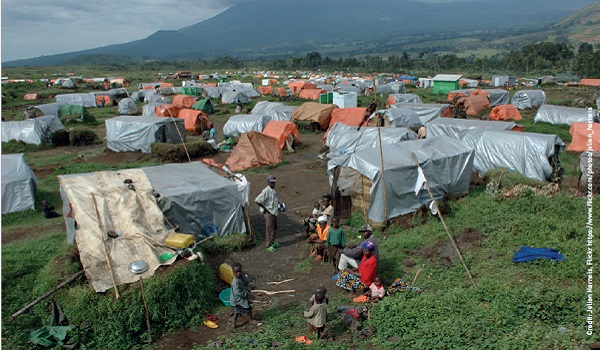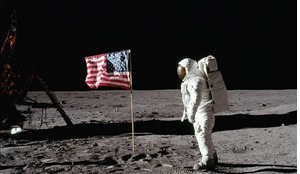Observing the paths of Near Earth Objects isn’t enough to deal with the threat of a major impact, as recent rehearsal exercises have demonstrated. So many uncertainties exist that it is possible that we will not be able to deflect an incoming object. We may be forced to deal with the aftermath of a collision. Establishing effective contingency arrangements for civil protection against asteroid strikes provides us with the ability to constantly improve our responses to this naturally occurring disaster.
Once an asteroid is discovered to be on a collision course with the Earth, extremely precise tracking is essential. Its progress will be closely followed with optical telescopes, radar and spacecraft missions with transponders that verify its possible impact location, orbit and speed.
Co-operation amongst observers and space agencies with upgraded ground-based radar is essential as physical observations are also needed to determine of what the object is made, how dense it is and to find out if it is a binary object composed of two asteroids rather than one.
But this is only the start of a process that will eventually involve governments in planning for disaster if the asteroid is indeed heading for a future impact with Earth.
When asteroids and comets are discovered, uncertainties surround their exact location - sometimes for months or even years. This uncertainty is due to the short orbital track available for the initial observation. Uncertainty also exists as to the extent of the scale of a NEO impact, and there are six main reasons for this. First, it’s not known precisely how many Near Earth Objects (NEOs) could potentially collide with Earth. Second, it is not possible to determine the mean impact rates for objects between 50m and 140m in diameter. Third, the composition of NEOs is unknown. Only by conducting a characterisation mission by either radar or spacecraft is it possible to determine what they are made of, or to what extent they may be intact objects or loosely formed bodies
 Radar images taken by Goldstone, like these of 1999 JD6, tell us an asteroid’s speed, size and composition
Radar images taken by Goldstone, like these of 1999 JD6, tell us an asteroid’s speed, size and composition
Fourth, even though the size, mass, density, velocity and speed of a NEO may be obtained, the collision effects will vary. It depends where in the atmosphere the object becomes fragmented and the location of the impact site, which could be in shallow or deep water. If on land, it depends on the geology of the area. Fifth, the effects may be global, such as climate change or tsunamis. Sixth, it is not clear what size or even which type of NEO would cause these effects.
Similarly, the effects of a NEO impact are determined by a number of factors. They include the mass and speed of the NEO, which will determine its velocity, along with the angle of its approach to the Earth and the density, diameter, composition and structure of the NEO.
Therefore, tracking is essential in order to effectively be able to determine the impact effects. Reliance and dependence on the information provided from the NEO Discovery and Follow-Up observations, as well as the data received from the characterisation and mitigation missions, is crucial to understanding the risks. This astronomical data is required in order to reduce the uncertainties surrounding asteroid impact events, and to inform the disaster management communities of the type of contingency planning arrangements that need to be put in place well in advance of an impact event.
Two disaster management exercises took place relatively recently: the first in April 2013 and the second in April 2015. Both of these illustrated that greater emphasis needs to be placed on the requirement for more precise tracking.
The first exercise was admittedly rather one dimensional. Effectively the scientific, technical and engineering community made a series of requests and recommendations to the government in response to the discovery of a hazardous, fictitious asteroid 2013 PDC-E, on 16 April 2013.
The 200-300m stony asteroid had an initial impact probability of 0.8% in 2028. The impact velocity, if it were to impact, was around 12.4 km/sec and the energy release would be around 300 megatons of TNT. There was a 1.2 km ‘keyhole’ during a close approach with the Earth in 2023. If it passed through this keyhole, it would impact in 2028. The risk corridor extended from Indonesia to Africa, across the Mediterranean Sea through France, the United Kingdom, across the Arctic Ocean and up through to Greenland.
Even if you knew precisely what the physical properties of the impact object would be, it remains very difficult to calculate the altitude at which it would explode.
The second exercise provided the scientific advisors with an environment in which they could interact with members of the public, the disaster management community and senior political leaders in order to inform the decision-making process. The political presence was provided by role-playing senior executives and scientists, which provided the scientific advisors with the opportunity to hone their briefing and communication skills to a wider audience. The members of the public were real, and so too were the representatives from the disaster management community.
The specific hazard in this exercise involved another hypothetical near-Earth asteroid, designated 2015 PDC, which was predicted to pass very close to Earth on 3 September 2022. The asteroid was ‘discovered’ on 13 April 2015 and had been tracked continuously for two months by observations around the world. Predictions for the asteroid’s encounter in 2022 indicated that, although unlikely, an Earth impact could not be ruled out. The likelihood of impact was about 0.9% or 1 chance in 110, according to the International Asteroid Warning Network (IAWN), a worldwide partnership of agencies that detects, monitors and tracks potentially hazardous asteroids.
Both of these exercise scenarios provided the participants with a five to ten year warning period, in order to enable the design and launch of several deflection mitigation missions, and equally for civil protection arrangements to be made.
 Participants in the rehearsal exercise for hypothetical asteroid 2015 PDC had to deal with a 20km-long object destined to hit Dhaka, the capital of Bangladesh.
Participants in the rehearsal exercise for hypothetical asteroid 2015 PDC had to deal with a 20km-long object destined to hit Dhaka, the capital of Bangladesh.
During the 2015 exercise, Dr Mark Boslough advised that the biggest current risk is from a low altitude Type 2 (Libyan Desert) airburst. If such an airburst were to occur, it was not certain at what altitude the explosion would take place because uncertainty surrounded the strength and the shape of the fragment. Even if you knew precisely what the physical properties of the impact object would be, it remains very difficult to calculate the altitude at which it would explode.
With seven years’ warning time, shelters can be enhanced to ensure that either they are able to withstand the impact effects
Although the tracking observations indicated that the fictitious asteroid posed a serious risk of impacting Earth on 3 September 2022, with an estimated likelihood of impact at 43%, a number of problems were encountered in relation to tracking and providing updated estimates. As the object passed on the other side of the Sun, as viewed from Earth, it became unobservable. (A satellite or spacecraft is needed to conduct observations when the asteroid passes on the other side of the Sun).
This meant it was also impossible to observe the results of a mission sent to deflect the asteroid, because the asteroid was within 30 degrees of the Sun, and solar elongation became smaller. The way the orbits work, it took about a year for the asteroid to finally emerge from behind the Sun and the ground-based observations could resume.
When the asteroid did re-emerge from behind the Sun, the fragment sizes were still uncertain because the object was so faint. It was very difficult to determine the size when it was simply a point of light. The best size estimate was provided by images from the observer spacecraft. It was not possible to refine the size based on ground-based observations.
It was possible, over the following six months, to continuously track the asteroid as it approached the Earth and remained in the night-time sky. The orbit accuracy dramatically improved and the impact footprint dramatically shrank in size. The location of the impact was known to within 100km some four months before the impact, and to within about 50km one month before impact. The asteroid then became unobservable again, as it had an orbit very much like Cheylabinsk and went into the daylight sky for its final plunge.
During that time it was not possible to observe it using optical telescopes. However, some radar stations would be able to observe it. Arecibo is sufficiently powerful but did not have the capability of pointing at the asteroid. So observers had to wait for it to come within range of the Goldstone Tracking Station, which eventually occurred seven days before the impact. When that happened, the predicted impact location could be constrained to within 15km.
 Eagle Dome in Woodsboro, Texas is a hurricane refuge as well as a sports arena - it can survive winds in excess of 200mph
Eagle Dome in Woodsboro, Texas is a hurricane refuge as well as a sports arena - it can survive winds in excess of 200mph
As a result, radar observations from Goldstone detected the fragment of the asteroid on its final approach, and provided distinctive measurements, not only of the trajectory but actual images of the asteroid that was headed towards Earth. These observations effectively collapsed the uncertainties. Based on the radar observations, IAWN predicted that this small fragment, which broke off the asteroid during the deflection mission, would enter the atmosphere over Dhaka, Bangladesh on 3 September 2022 at 0950 local time.
It was possible to make the calculations from the radar observations. The object would enter the atmosphere at 16km per second (36,000mph) at an angle, at Dhaka, of 36 degrees from the horizontal. The size was approximately 80m in diameter and its composition was of stone. This impact into the atmosphere was calculated to release about 18 to 25 megatons of energy. From the observations, the analysis was that the object would almost certainly explode in the atmosphere as an airburst, much like the Tunguska explosion in 1908. At the widest point, the area would be mostly impacted by wind speeds of 15-20 metres per second. In the primary impact area, there would be complete destruction.
To deal with the devastation, the disaster management communities identified two different ‘resource packages’: one set of resources for land and one for tsunami. Some adjustments would need to be made to the resource package within each country based on their specific requirements. In time, it would be possible to determine where those resources would be best positioned, what type of equipment was needed and where it should be located for a quick response.
Initially, the scenarios would be analysed based on current capabilities, identifying the additional resources required to be put in place in advance of the impact event. The government, now that they had more particular information, could also begin negotiations with contractors and other nations for restoration and could identify everything they needed for recovery. There is no reason why they needed to wait for those discussions; they could easily have those issues resolved well in advance.
Tented refugee camps might be the only option available for events such as natural disasters or hostile activities. However in this scenario they are not entirely appropriate. Seven years’ warning time should have enabled more effective and robust plans to be made in order to save not just lives, but livelihoods as well. Where camps are provided under canvas, farmers may not be able to take their livestock with them, so a much more sustainable solution needs to be found. Depending on the nature of the impact, NATO military assistance could perhaps be sought in advance. NATO could provide mobile infrastructure such as mobile hospitals, civilian and military doctors and nurses, in addition to medical supplies in concert with IOs, NGOs and organisations such as Medicins Sans Frontiers.
Understandably, as a result of the nature of the exercise participants, the focus of both of the exercises was on the deflection and disruption mitigation methods, with a lesser emphasis on effective and robust disaster management arrangements. Sadly the latter didn’t go much beyond identifying the need for evacuation, without stipulating the exact plans for re-housing displaced people. The focus seemed to be more on response and recovery than on making effective pre-planning arrangements offering more than simply establishing refugee camps under canvass.
Given the warning time available, more consideration could surely have been given to relocating communities. Additionally, if the asteroid had landed in the South China Sea, more arrangements could have been made to maintain and enhance existing sea defences, and to build new ones, to protect the coastlines against the increased wave heights and storm surges associated with an impact.
Greater consideration is required in determining proportionate and effective contingency planning arrangements. These arrangements need to be far more sophisticated than those used in readiness for natural hazards in general. We are fortunate that we will have advanced warning, from a few hours to a few years. This luxury of time is not afforded to us by any other natural hazard. As such, a paradigm shift is required, from response and recovery arrangements to pre-planning initiatives and activities like identifying areas where people can be relocated to safety, well before an impact event occurs.
Effective survival solutions are already in place in some parts of the world where partial ownerships, similar to a timeshare, are offered in underground shelter communities. With seven years’ warning time, these shelters can be enhanced to ensure that either they are able to withstand the impact effects or they are located a safe distance away from the risk corridor while still within relatively easy reach of the areas likely to be affected. Consideration could also be given to larger shelters accommodating hundreds or even thousands of people. Evacuation plans could then be put in place and rehearsed, which would provide potential evacuees with the ability to acclimatise themselves to such an environment - again, well in advance of an impact event.
There are other suggested contingency arrangements, including the colonization of Mars. While these may be possible in the future, a subterranean solution may be far more cost effective and easier to prepare for. Just as air travel still poses a degree of apprehension for some people, so space travel may provide emotional and financial challenges such as being able to practice evacuation drills and getting used to a new way of life on Mars.
 Management of camps for displaced persons, like Kibumba in the Democratic Republic of Congo, would be possible with the advanced notice afforded by an asteroid impact
Management of camps for displaced persons, like Kibumba in the Democratic Republic of Congo, would be possible with the advanced notice afforded by an asteroid impact
As an advocate for planning for the worst case scenario, and hoping for the best, I believe that establishing effective contingency arrangements for civil protection provides us with the ability to constantly improve our responses to frequently occurring natural hazards such as tsunamis, earthquakes, hurricanes, monsoons, cyclones and typhoons.
But given the pre-event warning time that detection and tracking systems can provide, there is no reason why our planning for an asteroid impact event should not take us to a whole new level of preparedness and response. Only by working together will the global space and disaster management communities persuade governments and supra-national organisations that this is an aspiration worth aiming for and which should be prioritised accordingly.














